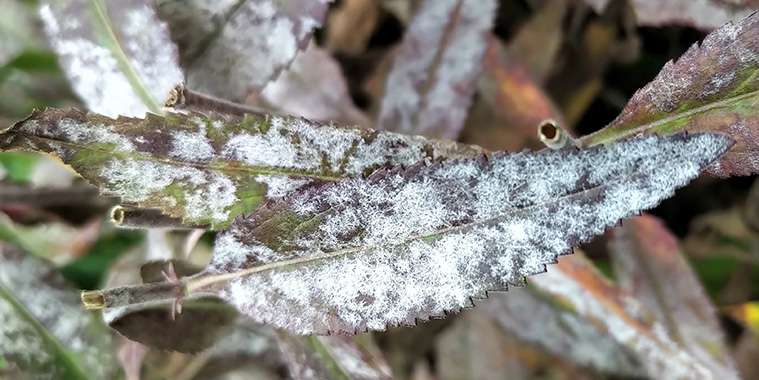By Dorothy Dobbie
Powdery mildew, when mature, looks just like someone came to your garden with a sifter of flour. The good news is that if it’s on your bee balm, it won’t spread to your phlox. This is a host-specific infection.
Curling leaves could be an early stage of powdery mildew, which starts out looking a little like a blister, causing the leaf to curl. Later it will develop the tell-tale powdery look on the upper side of the leaf. Check carefully. Aphids will cause leaf edges to curl, but they can also spread powdery mildew.
When the weather is cool (10 to 26 C) and humid (50 per cent to 90 per cent) and the soil is low in moisture, conditions are just right, especially if light levels are low. Contrary to popular belief, water on the leaves does not promote the growth of the mildew — high humidity at leaf level does. Air circulation is also important.
The mildew spores will overwinter on leaf debris and inside leaf buds so be sure to clean up and dispose of any infected materials.
You can’t really cure the disease once it starts, (although some people say that dormant oil spray will eradicate the fungus). Most recommend using a preventative. One of the best remedies is home-made mixing one part milk to two parts water in your sprayer. Other home-made remedies: can mix one tablespoon of baking soda to one teaspoon of dormant oil and one tablespoon of vegetable oil to one gallon of water; one part mouthwash to three parts water; two to three tablespoons apple cider vinegar (5 percent) to one gallon of water; and, finally, four tablespoons hydrogen peroxide to one pint of water. Any of these is said to kill the spores. You can also spray with sulfur, lime-sulfur or copper. Spray weekly, both sides of the leaf.
Downy mildew, on the other hand, is an infection that it not truly a fungus, but is a mould that is related to the disease that causes damping off in seedlings. It too is plant-specific, affecting Impatiens walleriana, our pretty little busy Lizzies. The infection has taken hold in the production facilities some big growers who are predicting that the plant will disappear.
Symptoms include leaves that turn light yellow or a stippled yellow and green. Leaf edges curl downward and look wilted. Then a fluffy growth appears on the lower surface of the leaf. The plant is stunted, leaves are small. When wet, the stems and leaves turn mushy. Dispose of the plant. The spores can survive eight to 10 years in zone 3 soil. There are new impatiens hybrids that are resistant: sun impatiens is larger, mounded plants with many blooms.
You can tell the difference between powdery and downy mildew by looking at the underside of the leaf. Downy mildew affects both top and undersides. Powdery mildew affects only the top of the leaf.
Be sure to cut down all badly infected plant and dispose of their bodies so as to prevent infecting the soil for the next year.
Dorothy Dobbie is the publisher of Manitoba Gardener. You can find the magazine at newsstands or on line at localgardener.net. Listen to Dorothy on CJNU 93.7 FM at 8 on Sunday mornings.



